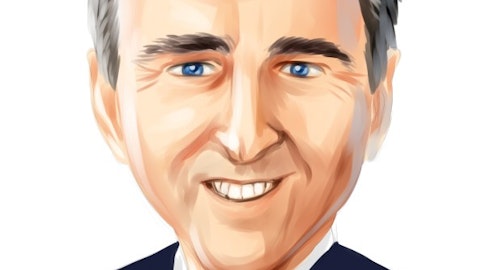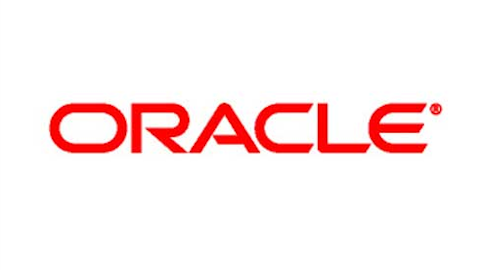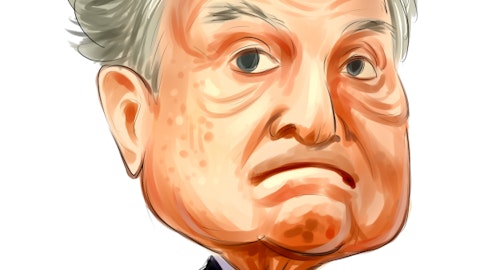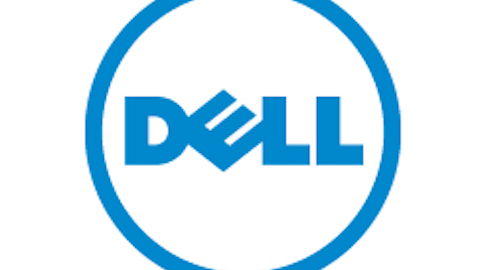
Moreover, he did not short sell based on valuation. The reasons he shorted Hewlett-Packard Company (NYSE:HPQ) and Dell Inc. (NASDAQ:DELL) were due to the overall weakening global PC industry and the R&D accounting that both companies have been using.
Very little R&D spending
Jim Chanos said that both Hewlett-Packard Company (NYSE:HPQ) and Dell Inc. (NASDAQ:DELL) have spent very little on R&D. That was why both companies could report better earnings and free cash flow. Indeed, in 2012, Hewlett-Packard Company (NYSE:HPQ) generated nearly $120.36 billion in revenue, but it spent only $3.4 billion on research & development. Thus, R&D expenses accounted for only 2.82% of total revenue.
It is the same case with Dell. In fiscal 2012, Dell Inc. (NASDAQ:DELL) had around $56.94 billion in revenue, but it poured only around $1 billion for research and development activities. Thus, its R&D expenses represented only 1.88% of the total revenue. In the past five years, Hewlett-Packard Company (NYSE:HPQ)’s R&D expense as a percentage of total revenue fluctuated in the range of 2.46% to 2.99%, while Dell’s R&D expense as a percentage of revenue stayed in the small range of 1.07% to 1.88%.
The adjusted FCF looks much uglier
According to Jim Chanos, both companies have not done R&D internally, but they have been “acquiring” R&D. Consequently, the acquisition went to acquisition item in the investing cash flow section of the cash flow statement, not capital expenditure item. That is why Hewlett-Packard Company (NYSE:HPQ) and Dell Inc. (NASDAQ:DELL) have generated the consistent positive “free cash flow”.
| FCF (USD million) | 2008 | 2009 | 2010 | 2011 | 2012 |
|---|---|---|---|---|---|
| Hewlett-Packard | 11,601 | 9,684 | 7,789 | 8,100 | 6,865 |
| Dell | 1,454 | 3,539 | 3,525 | 4,852 | 2,770 |
However, if we factored in the acquisition amount, the free cash flow of both companies would be much worse.
| Adjusted FCF (USD million) | 2008 | 2009 | 2010 | 2011 | 2012 |
|---|---|---|---|---|---|
| Hewlett-Packard | 353 | 9,293 | -188 | -2,291 | 6,811 |
| Dell | 1,278 | -74 | 3,149 | 2,290 | -2,074 |
Normally, huge acquisitions don’t end so well. Hewlett-Packard’s adjusted FCF was the lowest in 2011 due to the huge amount of $10.3 billion it paid to acquire Autonomy. Fast forward only one year, Hewlett-Packard Company (NYSE:HPQ) had to write down as much as $8.8 billion on the Autonomy purchase, including $5 billion charges as a result of “serious accounting improprieties, disclosure failures and outright misrepresentation.”
Samsung is a pick for technology investors
In contrast, Samsung, the leading smartphone manufacturer, has been spending much larger amount on research and development. In the past five years, Samsung has consistently increased its R&D expenses, from 3.78 trillion Won ($3.4 billion) in 2008 to nearly 10.24 trillion Won ($9.21 billion). The R&D expense as a percentage of revenue has fluctuated in the range of 4.36% to 7.74%. In 2012, its R&D expenses accounted for around 7.25% of the total revenue.
Samsung is now the global leader in smartphones. According to IDC, in the fourth quarter of 2012, Samsung shipped around 63.7 million units of smartphones, a significant growth of 76% compared to the first quarter of last year when it shipped around 36.2 million units.
Samsung currently commands around 29% of the total global smartphone market. Apple Inc. (NASDAQ:AAPL) ranks second with only 47.8 million unit shipments, accounting for 21.8% of the total global market. For the whole year 2012, Samsung shipped around 215.8 million units, a much higher amount than Apple’s shipment of 136.8 million units.
Samsung is trading around $1,300 per share, with a total market cap of $170.10 billion. The market values Samsung quite cheaply at only 4 times EV/EBITDA. Interestingly, the valuation of Samsung is only a bit higher than that of Hewlett-Packard Company (NYSE:HPQ). At $20 per share, Hewlett-Packard is worth around $38.6 billion. It is valued at nearly 3.8 times EV/EBITDA. Dell Inc. (NASDAQ:DELL) is the most expensive of the trio. At $13.30 per share, Dell is worth $23.2 billion on the market. The market values Dell at 4.67 times EV/EBITDA.
My Foolish take
Indeed, with the leading global market position and the low valuation, Samsung deserves a position in the portfolio of technology investors. As both Hewlett-Packard and Dell Inc. (NASDAQ:DELL) have been growing via acquisitions and they are both big players in the weakening overall global PC industry, investors should not buy them based on their fundamentals.
The article R&D Investment Is Important to Consider Before Investing in Technology originally appeared on Fool.com and is written by Anh Hoang.
Copyright © 1995 – 2013 The Motley Fool, LLC. All rights reserved. The Motley Fool has a disclosure policy.



